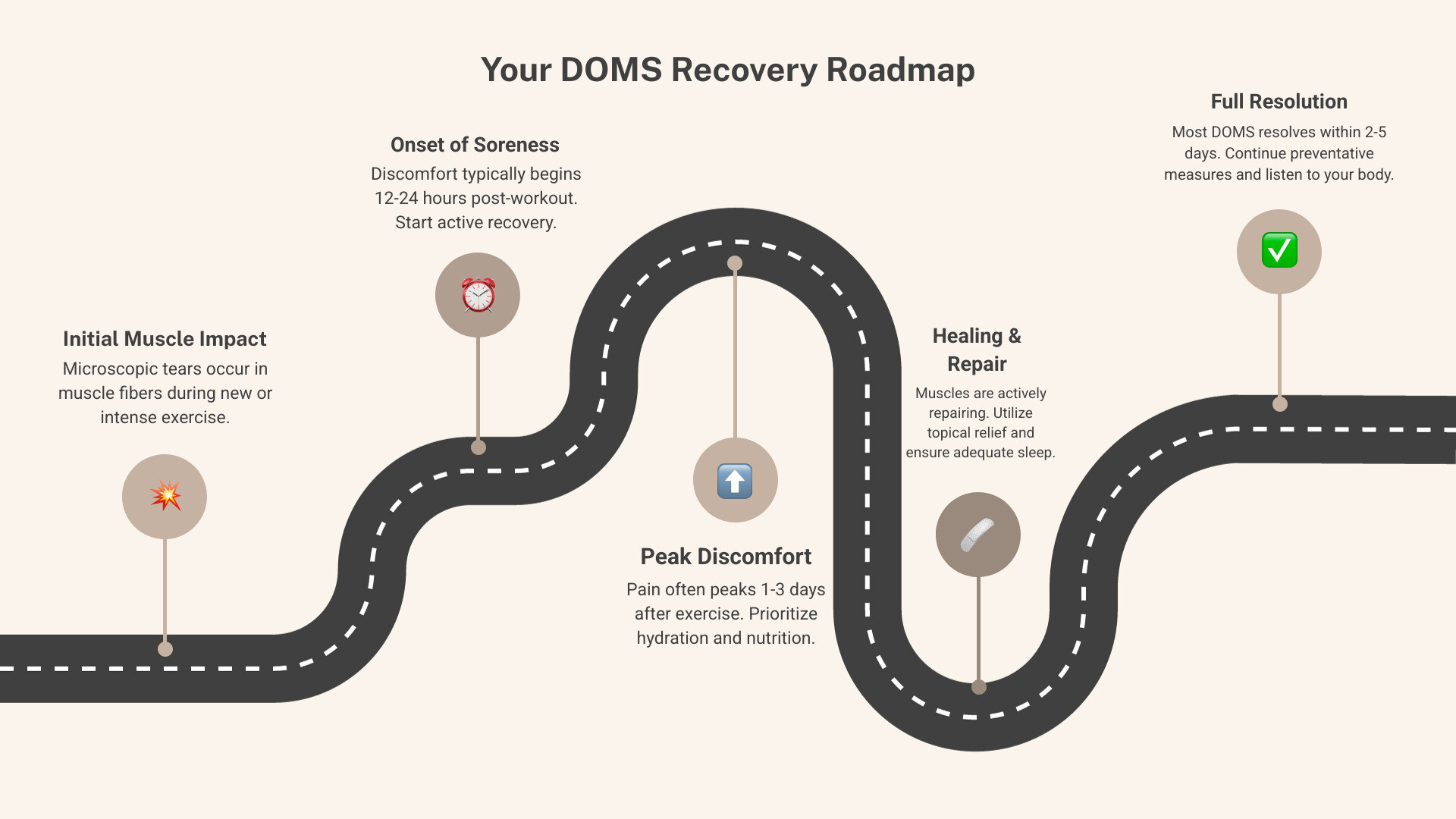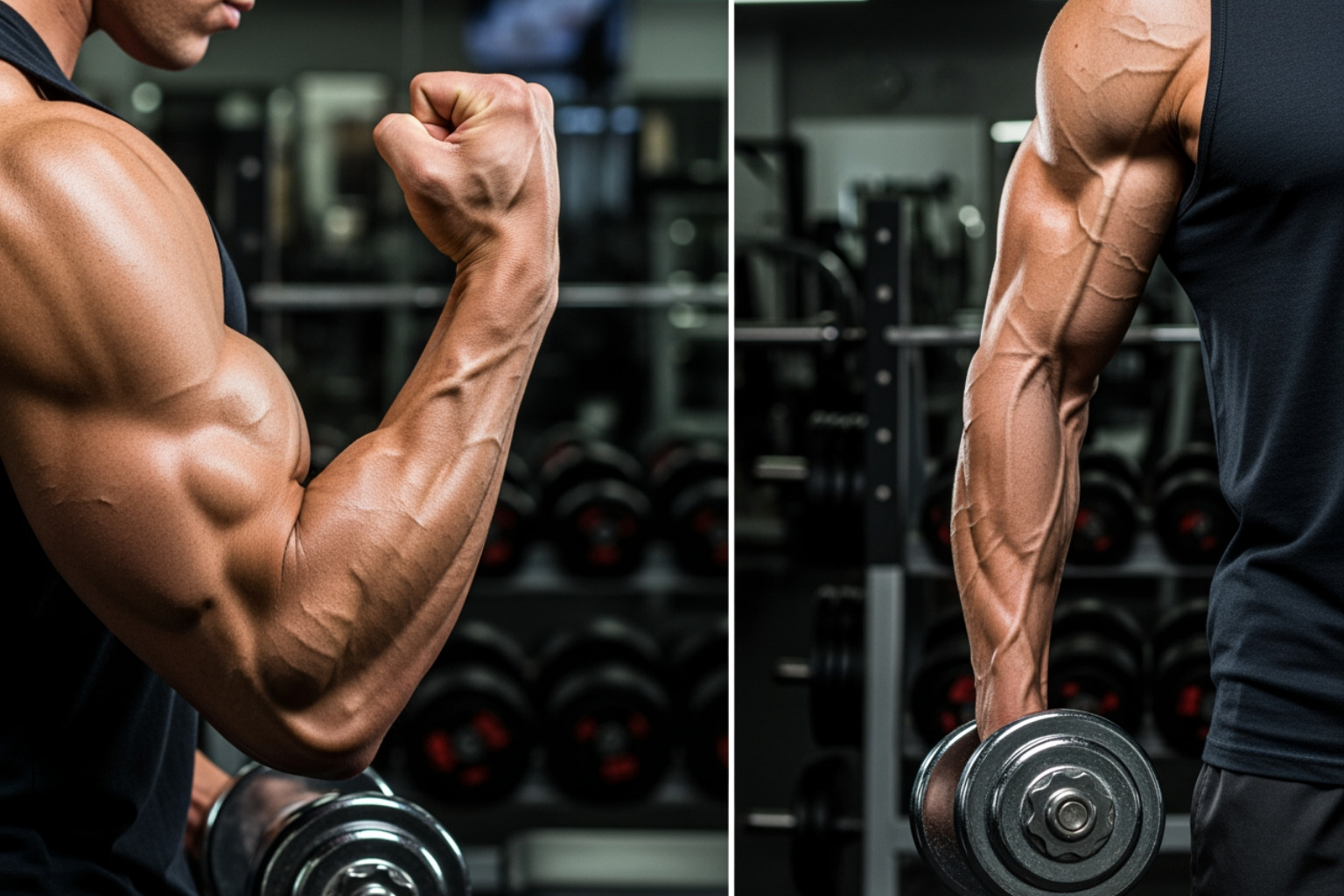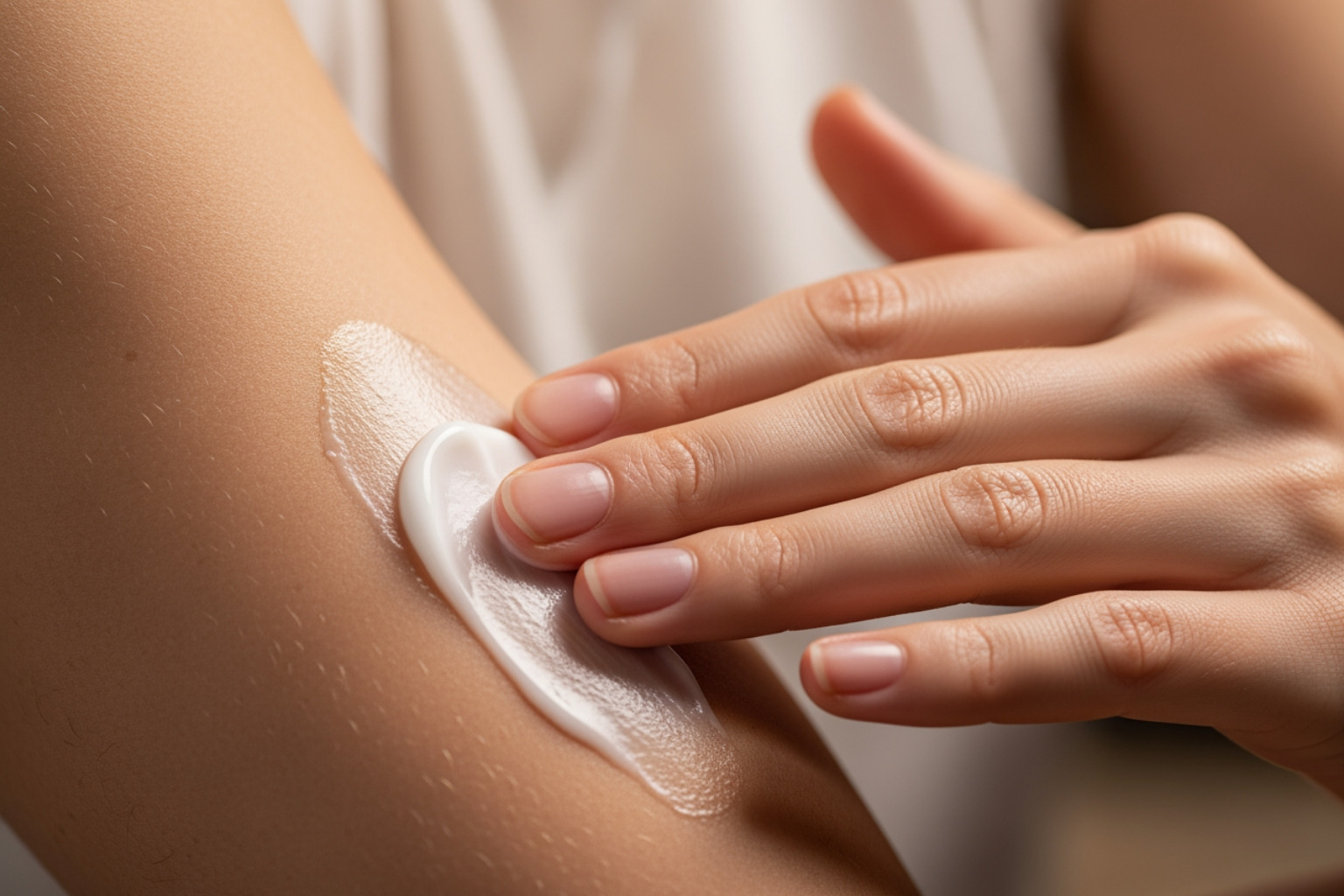Why Muscle Soreness After Workout Recovery Matters for Every Athlete
Muscle soreness after workout recovery is a universal challenge for athletes and active individuals. That familiar ache after a tough workout is known as Delayed Onset Muscle Soreness (DOMS), and managing it is key to consistent training.
Key facts about recovering from muscle soreness:
- DOMS begins 12-24 hours post-exercise and peaks 1-3 days later.
- It's caused by microscopic muscle tears, not lactic acid.
- Active recovery is more effective than complete rest.
- Hydration, nutrition, and sleep are crucial for healing.
- Topical pain relief creams offer targeted comfort.
- Soreness usually resolves in 2-5 days; severe, lasting pain requires medical advice.
You don't have to sacrifice training momentum for recovery. This guide will explain the causes of post-workout aches, how to differentiate soreness from injury, and the best methods to speed up recovery while staying active.
I'm Tony Enrico, and my career is dedicated to helping people find relief from muscle and nerve pain. I've seen how proper muscle soreness after workout recovery strategies empower athletes to train consistently and live without pain.

Muscle soreness after workout recovery basics:
Understanding Post-Workout Muscle Soreness
That ache you feel the day after a tough workout is your body signaling that it's repairing and rebuilding. Let's explore what's happening beneath the surface.
What is Delayed Onset Muscle Soreness (DOMS)?
Delayed Onset Muscle Soreness (DOMS) is the specific ache and stiffness that appears hours after exercise, distinct from the burn you feel during a workout. According to the American College of Sports Medicine.pdf), DOMS typically starts 12 to 24 hours after exercise, peaking one to three days later. It affects everyone, from seasoned athletes to beginners.
A common myth is that DOMS is caused by lactic acid buildup. The real culprit is microscopic tears in your muscle fibers created during exercise. This damage triggers an inflammatory response as your body begins to repair the tissue, resulting in the tenderness and stiffness you feel. For more details on what's happening in your muscles, see our guide on muscle pain.
Common Symptoms and Causes of DOMS
DOMS is characterized by a dull, aching sensation in the worked muscles, along with stiffness, tenderness to the touch, reduced strength, and a limited range of motion. Activities like climbing stairs can suddenly feel much harder.
Exercises involving eccentric contractions (where muscles lengthen under load) are the most common triggers. Examples include the lowering phase of a squat or bicep curl, or running downhill. These movements create more microscopic damage. Starting a new routine, trying a new exercise, or increasing intensity are also common causes of DOMS.

Is Soreness a Sign of a 'Good' Workout?
The "no pain, no gain" mindset is pervasive, but is soreness the best measure of a good workout? Not necessarily. While soreness indicates you've challenged your muscles enough to stimulate adaptation, it's not the only metric for a productive session. As your muscles adapt to training, you'll likely experience less soreness even as you get stronger.
Lack of soreness doesn't mean lack of progress. Constantly chasing extreme soreness can lead to overtraining, injury, and burnout. The inflammation from muscle damage is part of the growth process, but smart training involves listening to your body. Sustainable progress doesn't require being in pain for days after every workout. For more on this, read: Do DOMS mean I had a good workout?
The Best Strategies for Muscle Soreness After Workout Recovery
Managing post-workout aches is simpler than you might think. Let's explore the most effective strategies for muscle soreness after workout recovery.
Active Recovery and Gentle Movement
While resting on the couch is tempting, gentle movement is a more powerful tool for recovery. Active recovery increases blood flow to sore muscles, flushing out waste and delivering nutrients to support repair. This increased circulation can significantly reduce stiffness.
Keep the effort level low (around a 3 out of 10). Effective active recovery includes:
- Walking: A 15-minute stroll can work wonders.
- Gentle stretching: Maintain flexibility without pushing into pain.
- Light yoga: Promotes circulation and mental relaxation.
- Mobility drills: Gentle arm circles or leg swings keep joints mobile.
As confirmed by the American Academy of Family Physicians, staying active helps prevent stiffness. For more tips, see our guide on how to recover like a pro.
The Role of Hydration and Nutrition in Recovery
What you eat and drink post-workout is critical for muscle repair. Hydration is essential for transporting nutrients and flushing out waste. Dehydration can prolong soreness, as a 2005 study showed that proper hydration significantly reduced muscle soreness. Drink water before, during, and after your workout.
For nutrition, focus on these key components:
- Protein: Provides amino acids to rebuild muscle. Aim for 20-40 grams within 30 minutes post-workout to kick-start repair.
- Carbohydrates: Replenish glycogen stores. Pair 20-40 grams of carbs with your protein for optimal recovery.
- Vitamins and Minerals: Nutrients like vitamin C and zinc are crucial for tissue healing, according to the Academy of Nutrition and Dietetics. Consistent daily protein intake is also vital for ongoing repair. Learn more about how muscle recovery protein shakes can help.

Using Topical Solutions and Self-Massage for Muscle Soreness After Workout Recovery
For extra relief, hands-on care can make a big difference. Self-massage techniques like gentle kneading increase blood flow and ease aches. A 2020 review found that sports massage can improve flexibility and reduce DOMS pain.
Other effective methods include:
- Foam rolling: Use your body weight to apply pressure to tight muscles, releasing tension and improving blood flow, a benefit supported by research on self-myofascial release.
- Massage guns: Percussive therapy delivers pressure deep into muscle tissue. Lightly sweep over the muscle for 3-5 passes, following safety guidelines from experts.
Topical pain relief creams provide targeted comfort. Ingredients like menthol and arnica create a cooling sensation that distracts from pain, allowing you to stay active. Our Neuropasil creams are designed for muscle soreness after workout recovery, combining Aloe, Urea, and Menthol for fast, soothing relief. Explore the ultimate guide to muscle relief cream and find menthol's secret: how it soothes your aches.

The Importance of Rest and Prevention
Effective muscle soreness after workout recovery isn't just about active strategies; it's also about smart rest and prevention. These foundational elements are often overlooked but are crucial for long-term progress.
How Sleep Boosts Your Muscle Recovery
Sleep is arguably the most critical recovery tool. During deep, non-rapid eye movement (NREM) sleep, your body works to repair muscle tissue. It ramps up protein synthesis and releases human growth hormone, both essential for healing and growth. Skimping on sleep interrupts this natural repair process, leading to prolonged soreness and increased injury risk.
The Sleep Foundation recommends at least seven hours of quality sleep per night for anyone serious about recovery. Think of it as scheduled maintenance for your body.
Effective Methods for Preventing or Minimizing DOMS
While you can't eliminate DOMS entirely when challenging yourself, you can significantly reduce its severity by working smarter.
- Progressive Overload: Gradually increase your workout intensity, duration, or volume. Avoid sudden, dramatic jumps to give your muscles time to adapt.
- Dynamic Warm-ups: Before every workout, spend 5-10 minutes on dynamic movements to increase blood flow and prepare muscles for work. Evidence suggests this can reduce soreness for up to two days.
- Cool-downs: While the same 2007 study found that cool-downs did not reduce soreness, ending your session with static stretching (holding stretches for 20-30 seconds) can help improve long-term flexibility.
- Consistent Hydration: Staying hydrated throughout the day is key for prevention. Water helps transport nutrients and flush out waste products that contribute to soreness.
Incorporating these strategies builds a more sustainable and effective training program. For a full breakdown, see our guide on how to speed up DOMS recovery in 5 easy steps.
When Muscle Soreness Becomes a Medical Concern
While some muscle soreness after workout recovery is normal, it's crucial to know when an ache signals something more serious. Learning to listen to your body's warning signs is a key skill for any athlete.
Distinguishing Normal Soreness from Injury
It can be hard to tell the difference between normal DOMS and an injury, but there are clear distinctions:
- Normal DOMS: A dull, generalized ache that often affects both sides of the body. It improves with gentle movement and fades over 2-5 days.
- Injury Pain: A sharp, sudden, and localized pain that worsens with movement. It may be accompanied by swelling or bruising.
In short: DOMS is a widespread ache that gets better with activity, while an injury is a specific pain that gets worse. If you have persistent, sharp pain, it's time to investigate. Learn more about muscle strain treatment.
Red Flags: When to See a Doctor for Your Muscle Soreness After Workout Recovery
Most soreness resolves with proper recovery, but some symptoms require immediate medical attention. See a doctor if you experience:
- Pain that lasts over 72 hours without improvement or gets worse.
- Debilitating pain that prevents normal daily activities.
- Severe swelling, numbness, or tingling in the affected area.
- Dark-colored urine (brown, red, or tea-colored) - this is an emergency signal.
- Inability to move a limb or profound weakness.
Your healthcare provider can offer a proper diagnosis. The Cleveland Clinic provides guidance on when to call the doctor for muscle pain.
Understanding Rhabdomyolysis and Other Serious Conditions
It's important to be aware of rare but serious conditions that can arise from extreme exertion.
Rhabdomyolysis, as described by the Cleveland Clinic, occurs when muscle fibers break down so rapidly that their contents flood the bloodstream, overwhelming the kidneys. Research shows this can lead to acute kidney injury. Symptoms include severe muscle pain disproportionate to the workout, profound weakness, and the critical warning sign: dark, tea-colored urine. Rhabdomyolysis is a medical emergency requiring immediate hospitalization. For those affected, our rhabdomyolysis recovery guide can help.
Compartment syndrome is another rare emergency where severe muscle swelling cuts off blood supply to nerves and muscle cells, causing extreme pain and inability to move the affected limb, as detailed in medical literature.
Knowing these warning signs is not meant to scare you, but to empower you to act quickly if something feels seriously wrong.
Frequently Asked Questions about Muscle Soreness and Recovery
Here are answers to common questions about muscle soreness after workout recovery.
Should I use ice or heat for sore muscles?
Both ice and heat have their place in recovery.
- Ice (Cryotherapy): Best for the first 24-48 hours after an intense workout or acute injury. It constricts blood vessels to numb pain and reduce swelling. Research suggests cold therapy can help reduce DOMS-related pain.
- Heat Therapy: Ideal for relieving stiffness and promoting relaxation once the acute phase has passed. A warm bath or heat wrap increases blood flow, delivering nutrients and easing aches, an effect supported by clinical studies on heat treatment.
Alternating between ice and heat can be effective. Listen to your body and choose what feels best.
Can I work out with DOMS?
Yes, light activity is usually beneficial. Active recovery, such as walking or gentle yoga, increases blood flow to sore muscles, which can alleviate stiffness and speed up recovery without causing more damage.
The key is to either work different muscle groups or keep the intensity very low. If your legs are sore, focus on an upper-body workout. However, if the soreness is severe or affects your form, take a true rest day. Pushing through intense pain can hinder recovery and increase injury risk.
Do pain relievers like NSAIDs help with DOMS?
Nonsteroidal anti-inflammatory drugs (NSAIDs) like ibuprofen can reduce DOMS-related pain by decreasing inflammation. However, there's a catch. Some studies suggest that high doses of NSAIDs might interfere with the muscle repair and adaptation process. The inflammation from exercise is a signal for your body to build stronger muscles, and suppressing it too aggressively could hinder those gains.
Our recommendation is to use NSAIDs sparingly, mainly for severe discomfort. For routine soreness, focus on other strategies like active recovery, nutrition, sleep, and topical pain relief creams. Natural, menthol-based creams like Neuropasil offer targeted comfort without the systemic effects of oral medications, supporting your body's natural healing process.
Conclusion: Your Ultimate Workout Recovery Plan
Post-workout ache doesn't have to derail your fitness goals. By implementing a smart muscle soreness after workout recovery plan, you can manage soreness effectively and continue building strength.
Recovery is a multi-faceted process. Combine these key strategies for the best results:
- Active Recovery: Gentle movement to increase blood flow.
- Nutrition & Hydration: Provide muscles with the fuel they need to rebuild.
- Quality Sleep: Allow your body time to repair itself.
- Targeted Relief: Use topical creams to ease discomfort where you need it.
Start with simple steps: take a walk the day after a tough workout, drink plenty of water, and prioritize 7-8 hours of sleep. For targeted relief, a cream like Neuropasil, with its blend of Menthol, Aloe, and Urea, can provide fast-acting comfort.
The goal isn't to eliminate soreness entirely, but to minimize its impact. By progressing gradually and staying consistent with your recovery, soreness will become more manageable. Most importantly, listen to your body. If you experience any red flags like severe pain or dark urine, seek medical attention.
Recover smart, not just hard. With these tools, you can push your limits and take care of your body. Ready to upgrade your recovery? Explore Neuropasil for fast post-workout relief and see why athletes trust it for their muscle soreness after workout recovery.
References
This guide on muscle soreness after workout recovery is based on scientific research and expert insights. The following sources were used to provide accurate, actionable information.
- Academy of Nutrition and Dietetics. Eating for Strength and Recovery After Sports Injury.
- American College of Sports Medicine (ACSM). (2011). Delayed Onset Muscle Soreness (DOMS).pdf).
- Cheatham SW, et al. (2015). The Effects of Self-Myofascial Release Using a Foam Roll or Roller Massager on Joint Range of Motion, Muscle Recovery, and Performance: A Systematic Review. International Journal of Sports Physical Therapy.
- Cleary, M. A., et al. (2005). Dehydration and Symptoms of Delayed-Onset Muscle Soreness in Hyperthermic Males. Journal of Athletic Training.
- Cleveland Clinic. Rhabdomyolysis.
- Cleveland Clinic. When to Call the Doctor for Muscle Pain.
- Davis, H. L., et al. (2020). The Effect of Sports Massage on Performance and Recovery: A Systematic Review and Meta-Analysis. Sports Medicine.
- FamilyDoctor.org. Sore Muscles.
- Healthline. What Is DOMS (Delayed Onset Muscle Soreness) and What Can I Do About It?.
- Hospital for Special Surgery. How to Use a Massage Gun Safely.
- Law, R. Y. W., & Herbert, R. D. (2007). Warm-up Reduces Delayed-Onset Muscle Soreness but Cool-down Does Not: A Randomised Controlled Trial. Australian Journal of Physiotherapy.
- Lilja, M., et al. (2018). High Doses of Anti-inflammatory Drugs Compromise Muscle Strength and Hypertrophic Adaptations to Resistance Training in Young Adults. Acta Physiologica.
- NHS inform. Pain and Injuries After Exercise.
- Petrofsky J, et al. (2017). The Efficacy of Sustained Heat Treatment on Delayed-Onset Muscle Soreness. Clinical Journal of Sport Medicine.
- Shroff, K., et al. (2021). Clinical Characteristics of Spinning-Induced Rhabdomyolysis and Other Causes of Rhabdomyolysis: A Comparative Study. Cureus.
- Sleep Foundation. (2023). How Much Sleep Do We Really Need?.
- Torlincasi AM, et al. (2023). Acute Compartment Syndrome. PubMed Books.
- Xiao F, et al. (2023). Effects of Cold Water Immersion After Exercise on Fatigue Recovery and Exercise Performance. Frontiers in Physiology.














